
The President’s Message:
I look forward to seeing everyone at the February meeting.
Our living history programs are unique and well received.
Be sure to attend.
All family members, friends, and Valentine sweethearts are invited.
Please pay your dues. Thank
you to everyone who has paid.
Gerridine LaRovere
February 8, 2023 Program:
Halos or Horns
A play in one act about a Planter, Traitor, Lawyer, or Spy
We will let the audience be the judge.
The Round Table Players will present this living history play at the
February 8, 2023 meeting.
This production will chronicle the life of a Confederate officer and
politician who may or may not have stolen over one million dollars from
the Confederate treasury.
Was he working for the Confederacy while being a United States cabinet
member? As a member of
General Pemberton’s staff how did evade being a prisoner of war at the
Siege of Vicksburg? How did
he live a luxurious life style when his largest plantation was burned to
the ground? These and other
fascinating questions will be answered by our resident actors William
McEachern and Gerridine LaRovere.
Join us for a fun and fact-filled evening of intrigue,
embezzlement, fraud, bank robbery, spying, and other vile and despicable
acts.
January 11, 2023
Program:
Russia’s Intriguing Role in America’s Civil War
 For
the 20th
time, Robert Macomber treated our Round Table to a great presentation.
Although most of us are quite familiar with Robert, for our new
members he is the author of the “Honor” series of historical novels.
These books, and there are 16 of them at last count, tell the story of
the late 19th
and early 20th
century via the fictional character of Peter Wake, USN. For
the 20th
time, Robert Macomber treated our Round Table to a great presentation.
Although most of us are quite familiar with Robert, for our new
members he is the author of the “Honor” series of historical novels.
These books, and there are 16 of them at last count, tell the story of
the late 19th
and early 20th
century via the fictional character of Peter Wake, USN.
Robert has been the recipient of the Patrick D. Smith Literary Award,
the American Library Association’s W.Y. Boyd Literary Award, a Gold and
Silver Medal winner in Popular Fiction from the Florida Book Awards, and
a host of other accolades spanning over two decades. He has earned
rare experiences like being Distinguished Lecturer at NATO HQs
[Belgium], and, for ten years, was invited into the Distinguished
Military Author Series, Center for Army Analysis [Ft. Belvoir]. Robert
was named Florida Author of the Year in 2020 by the FL Writers
Association, and is a captivating storyteller helping spread a love for
history!
From New York to Alaska and California, who would imagine that the
Russian Empire was involved in the U.S. Civil War?
In the 19th
century Russia was (and still is) a vast country stretching from the
Baltic Sea on the west to British Canada on the east.
There is, however, a problem for the Czar in St. Petersburg.
The Russian Empire has no warm water ports.
For a country building a large navy, this is unacceptable.
Driven by the belief that a powerful navy makes your country a
respected “great power,” Imperial Russia tried to expand the empire to
include such a port.
The direction they chose to contest was eastern Europe into the Black
Sea and central Asia south to the Indian Ocean.
The century-long adversarial efforts of Imperial Russia and
Imperial Britain for domination of Central Asia was called "The Great
Game." British concern
about the Russian influence on Afghanistan led to the First Anglo-Afghan
War (from 1838 to 1842).
This led to the cartoon from
Punch
showing Afghanistan between the Russian bear and the British lion.
Note, the cartoon was from the second war in 1878.
The push into the Black Sea at first went well for Russia.
In 1853, Russian expansion led to the destruction of the Ottoman
fleet in Turkey. Just as it
looked like the Czar would get access to the Mediterranean Sea and
therefore the oceans of the world, fearing an Ottoman collapse, the
British and the French had their fleets enter the Black Sea in January
1854. The Crimean War was
on. These great powers
fought to a stalemate. Bob
noted the disastrous loss the British absorbed at the Battle of
Balaklava Sevastopol with the famous British charge of the Light
Brigade. The significance
of this war was not so much who won or lost, but for the modern weapons
that were on display and the fact that ten years later in 1863, when
Poland rebelled from the Russian Empire and Britain and France supported
her, the Russian Navy needed to get away from Mother Russia least they
were defeated in detail by the Royal Navy.
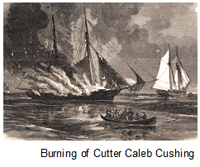 In
the late summer of 1863, the Baltic Fleet set sail for the east coast of
the United States and the Pacific Fleet headed for the west coast of
North America, Russian America.
The timing could not have been better for the Lincoln government.
New England had just been raided by a couple ships from the
Confederate “Navy.” It was
not so grand, but it was the result of a young lieutenant serving off
the coast of Brazil. This
hothead hatched a daring plan to sail a captured brig directly into the
Union's home waters and wreak havoc on their shipping lanes.
Burning or capturing more than twenty merchant vessels in less
than three weeks, and switching ships several times to elude capture,
the southern rampage caused widespread panic in northern cities, made
headlines in the major daily newspapers, and brought enormous pressure
on Gideon Welles to "stop the rebel pirate." In
the late summer of 1863, the Baltic Fleet set sail for the east coast of
the United States and the Pacific Fleet headed for the west coast of
North America, Russian America.
The timing could not have been better for the Lincoln government.
New England had just been raided by a couple ships from the
Confederate “Navy.” It was
not so grand, but it was the result of a young lieutenant serving off
the coast of Brazil. This
hothead hatched a daring plan to sail a captured brig directly into the
Union's home waters and wreak havoc on their shipping lanes.
Burning or capturing more than twenty merchant vessels in less
than three weeks, and switching ships several times to elude capture,
the southern rampage caused widespread panic in northern cities, made
headlines in the major daily newspapers, and brought enormous pressure
on Gideon Welles to "stop the rebel pirate."
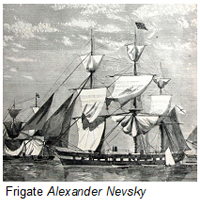 The
Union forces saw ships like the Russian frigate
Alexander Nevsky,
as she sailed into New York harbor, as a gift from above.
In addition to Confederate raiders, New York City had to contend
with draft riots, civilian unrest, and a lack of knowledge of where
Robert E. Lee might go next in his June invasion of Pennsylvania.
The Americans believed the Russians wanted to help.
Gideon Welles wrote in his diary: “In sending them to this
country there is something significant." and "God bless the Russians.”
Thus, the Russian fleet in New York was welcomed by both the
Russians as a harbor of safety from the Royal Navy, and by the Americans
as political and economic support of the Union.
It was time to celebrate.
Admiral Lisovski welcomed American leaders onboard the flagship.
With great pomp a delegation of American officers, some sixty
strong, were piped aboard.
They were treated in grand style. The
Union forces saw ships like the Russian frigate
Alexander Nevsky,
as she sailed into New York harbor, as a gift from above.
In addition to Confederate raiders, New York City had to contend
with draft riots, civilian unrest, and a lack of knowledge of where
Robert E. Lee might go next in his June invasion of Pennsylvania.
The Americans believed the Russians wanted to help.
Gideon Welles wrote in his diary: “In sending them to this
country there is something significant." and "God bless the Russians.”
Thus, the Russian fleet in New York was welcomed by both the
Russians as a harbor of safety from the Royal Navy, and by the Americans
as political and economic support of the Union.
It was time to celebrate.
Admiral Lisovski welcomed American leaders onboard the flagship.
With great pomp a delegation of American officers, some sixty
strong, were piped aboard.
They were treated in grand style.
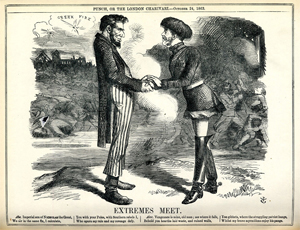 Not
to be out done, the cream of New York society gave an elaborate party
for their Russian guests.
Setting type is too expensive these days to reproduce the menu here in
all its long abundance the
Herald
stated. However, as the
World
reported at the time, since “the ovation and ball is one which may leave
its traces on centuries to come, we give, for the sake of history, an
account of the principal edibles used, viz.: Twelve thousand
oysters—10,000 poulette and 2,000 pickled. Twelve monster salmon—30 lbs.
each. Twelve hundred game birds.
Two hundred and fifty turkeys.
Four hundred chickens.
One thousand pounds of tenderloin.
One hundred pyramids of pastry.
One thousand large loaves.
Three thousand five hundred bottles of wine.” Not
to be out done, the cream of New York society gave an elaborate party
for their Russian guests.
Setting type is too expensive these days to reproduce the menu here in
all its long abundance the
Herald
stated. However, as the
World
reported at the time, since “the ovation and ball is one which may leave
its traces on centuries to come, we give, for the sake of history, an
account of the principal edibles used, viz.: Twelve thousand
oysters—10,000 poulette and 2,000 pickled. Twelve monster salmon—30 lbs.
each. Twelve hundred game birds.
Two hundred and fifty turkeys.
Four hundred chickens.
One thousand pounds of tenderloin.
One hundred pyramids of pastry.
One thousand large loaves.
Three thousand five hundred bottles of wine.”
Parties were not the only order of the day.
Elaborate field trips were arranged.
Some were mundane, like the tour of naval installations in New
York City. Others were
grand like the officers of the Russian fleet excursion to Niagara Falls.
Included in this trip was a young lieutenant named Nikolai
Rimsky-Korsakov. He would
go on to be a great composer of such works as
Scheherazade
and the
Flight of the Bumblebee.
Ten months after their arrival for what was thought to be a short
goodwill port call, the Russian fleet finally left New York.
The Russians collected $4,760 for the poor of the city ($76,000
in today’s money) given by the Russian officers.
In 1865, America gave the Russian the plans to the very
successful Passaic-class naval monitor.
The Russian built ten of them for their navy.
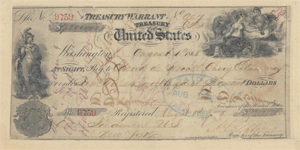 In
return, something momentous was considered.
At the aftermath of the Crimean War, Russian Tsar Alexander II
began exploring the possibility of selling Alaska, which would be
difficult to defend in any future war from being conquered by Russia's
archrival, the United Kingdom—whose dominion was Canada.
Following the end of the American Civil War, U.S. Secretary of
State William Seward entered into negotiations with Russian minister
Eduard de Stoeckl for the purchase of Alaska.
Seward and Stoeckl agreed to a treaty on March 30, 1867, and the
treaty was ratified by the United States Senate by a wide margin.
Both countries felt this was a good deal.
That marked the high-water mark of good relations. In
return, something momentous was considered.
At the aftermath of the Crimean War, Russian Tsar Alexander II
began exploring the possibility of selling Alaska, which would be
difficult to defend in any future war from being conquered by Russia's
archrival, the United Kingdom—whose dominion was Canada.
Following the end of the American Civil War, U.S. Secretary of
State William Seward entered into negotiations with Russian minister
Eduard de Stoeckl for the purchase of Alaska.
Seward and Stoeckl agreed to a treaty on March 30, 1867, and the
treaty was ratified by the United States Senate by a wide margin.
Both countries felt this was a good deal.
That marked the high-water mark of good relations.
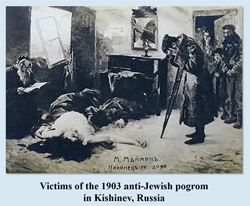 But
this marriage of convenience could not last.
The political nature of the two countries was too divergent.
The United States had fought a civil war to preserve the
Constitution, maintain the Union, and liberate the slaves, while Russia
was fighting wars of domination of bordering independent states, and
horribly persecuting their Jewish citizenry.
As the 19th
century drew to a close, Americans came to view czarist Russia as an
evil and oppressive state.
We believed we were on the side of the angels by defending small
countries in their attempt to free themselves from the shackles of the
imperialists. We fought a
war against Spain to justify that belief.
The United States had an open immigration policy.
Many of the refugees had come here to escape repressive
governments like Russia.
The Jews in particular were persecuted by Russia.
The press in the eastern states described in detail the 1903
deadly anti-Jewish pogrom in Kishinev, Russia.
And thus ended the brief period of good Russian
relations—forever. But
this marriage of convenience could not last.
The political nature of the two countries was too divergent.
The United States had fought a civil war to preserve the
Constitution, maintain the Union, and liberate the slaves, while Russia
was fighting wars of domination of bordering independent states, and
horribly persecuting their Jewish citizenry.
As the 19th
century drew to a close, Americans came to view czarist Russia as an
evil and oppressive state.
We believed we were on the side of the angels by defending small
countries in their attempt to free themselves from the shackles of the
imperialists. We fought a
war against Spain to justify that belief.
The United States had an open immigration policy.
Many of the refugees had come here to escape repressive
governments like Russia.
The Jews in particular were persecuted by Russia.
The press in the eastern states described in detail the 1903
deadly anti-Jewish pogrom in Kishinev, Russia.
And thus ended the brief period of good Russian
relations—forever.
Last changed: 01/28/23 |

